Narrating Ancient Roman Heritage through Drawings and Digital Architectural Representation: From Historical Archives, UAV and LIDAR to Virtual-Visual Storytelling and HBIM Projects
Abstract
1. Introduction
2. State-of-the-Art
2.1. Dense Structure from Motion (DSfM) Applied to UAV Data
2.2. From Point Clouds to HBIM, VR and AR Environments
3. Materials and Methods
4. The Research Case Studies
4.1. The Appian Way and Its Tangible and Intangible Values: From the Roman Era to Piranesi, Canova, Valadier and Canina
4.2. Castrum Caetani: Cecilia Metella Mausoleum, Palace Caetani and S. Nicola church
5. 3D Survey Approach Based on Laser Scanning, Digital Photogrammetry and UAV Data Integration: From Point Clouds to High-Resolution Textured Models
6. Architectural Representation Scales: Digital Model Orientation for Archaeology, VR-AR and Preservation Purposes
UAV Data and Terrestrial Digital Photogrammetry for Augmented Reality: The Appian Way Case Study
- Digital survey (topographic, laser scanning, unique control geodetic network)
- Terrestrial and aerial photogrammetric survey, post-processing (point clouds and mesh model orientation)
- 3D drawing and NURBS modelling orientation for HBIM projects
- Quality check of the model produced (by element)
- HBIM conversion and data enrichment
- Common data environment and cloud sharing (BIM-based project shared)
- Real-time synchronisation between 3D models (NURBS-HBIM projects) and XR development platform
- 3D Mapping calibration and texture generation
- Virtual-visual storytelling definition and visual programming language
- VR and AR outputs, 3D animation and multimedia data production.
- BIM 360 Docs: Environment, common to all the other modules, is where data and project sharing and collaboration occur.
- BIM 360 Design: Design: Autodesk Collaboration for Revit allows one to work directly in Revit and collaborate simultaneously in the cloud.
- BIM 360 Glue: Interference checking and site planning.
- BIM 360 Build: Real construction site.
- BIM 360 Ops: Management and maintenance of the built work.
7. Design the Narrative Structure: Towards the Virtual-Visual Storytelling
- -
- Respecting the ‘5 W’ of journalism: linear and engaging story able to clarify who is the protagonist of the story, what happens in the story, where and when the story or period represented takes place, and finally, explicitly address the reason for which the story was created, explaining in the best possible way what are the factors that motivate the succession of the events of the narrated story;
- -
- Showing and not saying: indirectly communicate what you want to express, through the narration of events, ensuring that the target directly understands the message, thus reinforcing its authenticity and persuasive effectiveness;
- -
- Being original in narrating: the conservation of an overall organic nature of the narration to make it intelligible and credible for one’s reference audience;
- -
- Space for imagination and details: the attention and interest of the reference audience differentiate the story, characterising it as unique and inimitable.
8. Conclusions
Author Contributions
Funding
Data Availability Statement
Conflicts of Interest
References
- Docci, M.; Maestri, D. Manuale di Rilevamento Architettonico e Urbano; GLF Editori Laterza: Bari, Italy, 2020. [Google Scholar]
- Fiz, J.I.; Martín, P.M.; Cuesta, R.; Subías, E.; Codina, D.; Cartes, A. Examples and Results of Aerial Photogrammetry in Archeology with UAV: Geometric Documentation, High Resolution Multispectral Analysis, Models and 3D Printing. Drones 2022, 6, 59. [Google Scholar] [CrossRef]
- Bianchini, C.; Ippolito, A.; Bartolomei, C. The surveying and representation process applied to architecture: Non-contact methods for the documentation of cultural heritage. In Handbook of Research on Emerging Digital Tools for Architectural Surveying, Modeling, and Representation; IGI Global: Hershey, PA, USA, 2015; pp. 44–93. [Google Scholar]
- Brusaporci, S. Handbook of Research on Emerging Digital Tools for Architectural Surveying, Modeling, and Representation; IGI Global: Hershey, PA, USA, 2015. [Google Scholar]
- Muchiri, G.N.; Kimathi, S. A review of applications and potential applications of UAV. In Proceedings of the Sustainable Research and Innovation Conference, Pretoria, South Africa, 20–24 June 2022; pp. 280–283. [Google Scholar]
- Shadiev, R.; Yi, S. A systematic review of UAV applications to education. Interact. Learn. Environ. 2022, 1–30. [Google Scholar] [CrossRef]
- Aabid, A.; Parveez, B.; Parveen, N.; Khan, S.A.; Zayan, J.M.; Shabbir, O. Reviews on Design and Development of Unmanned Aerial Vehicle (Drone) for Different Applications. J. Mech. Eng. Res. Dev. 2022, 2022 45, 53–69. [Google Scholar]
- Pepe, M.; Alfio, V.S.; Costantino, D. UAV Platforms and the SfM-MVS Approach in the 3D Surveys and Modelling: A Review in the Cultural Heritage Field. Appl. Sci. 2022, 12, 12886. [Google Scholar] [CrossRef]
- Barba, S.; Limongello, M.; Parrinello, S.; Dell’Amico, A.; di Filippo, A. D-SITE. Drones. Systems of Information on Cultural Heritage for A Spatial and Social Investigation; Pavia University Press: Pavia, Italy, 2020; Volume 1. [Google Scholar]
- Ulvi, A. Using UAV Photogrammetric Technique for Monitoring, Change Detection, and Analysis of Archeological Excavation Sites. J. Comput. Cult. Herit. 2022, 15, 1–19. [Google Scholar] [CrossRef]
- Whitford, B.; Boyadzhiev, K.; Ivanov, M.; Tyufekchiev, K.; Boyadzhiev, Y. A Photogrammetry-Assisted Methodology for the Documentation of Complex Stratigraphic Relationships. Adv. Archaeol. Pr. 2022, 10, 428–439. [Google Scholar] [CrossRef]
- Bevilacqua, M.G.; Russo, M.; Giordano, A.; Spallone, R. 3D Reconstruction, Digital Twinning, and Virtual Reality: Architectural Heritage Applications. In Proceedings of the 2022 IEEE Conference on Virtual Reality and 3D User Interfaces Abstracts and Workshops (VRW), Christchurch, New Zealand, 12–16 March 2022; pp. 92–96. [Google Scholar]
- Attenni, M.; Bianchini, C.; Griffo, M.; Senatore, L.J. HBIM Meta-Modelling: 50 (and More) Shades of Grey. ISPRS Int. J. Geo-Inf. 2022, 11, 468. [Google Scholar] [CrossRef]
- Yang, X.; Grussenmeyer, P.; Koehl, M.; Macher, H.; Murtiyoso, A.; Landes, T. Review of built heritage modelling: Integration of HBIM and other information techniques. J. Cult. Herit. 2020, 46, 350–360. [Google Scholar] [CrossRef]
- Russo, M. AR in the Architecture Domain: State of the Art. Appl. Sci. 2021, 15, 6800. [Google Scholar] [CrossRef]
- Shariq, M.H.; Hughes, B.R. Revolutionising building inspection techniques to meet large-scale energy demands: A review of the state-of-the-art. Renew. Sustain. Energy Rev. 2020, 130, 109979. [Google Scholar] [CrossRef]
- Colomina, I.; Molina, P. Unmanned aerial systems for photogrammetry and remote sensing: A review. ISPRS J. Photogramm. Remote Sens. 2014, 92, 79–97. [Google Scholar] [CrossRef]
- Rakha, T.; Gorodetsky, A. Review of Unmanned Aerial System (UAS) applications in the built environment: Towards automated building inspection procedures using drones. Autom. Constr. 2018, 93, 252–264. [Google Scholar] [CrossRef]
- Kangunde, V.; Jamisola, R.S.; Theophilus, E.K. A review on drones controlled in real-time. Int. J. Dyn. Control 2021, 9, 1832–1846. [Google Scholar] [CrossRef] [PubMed]
- Russo, M. Imaging for archaeology: An instrument of reading and interpretation complex architecture. In Redibujando el Futuro de la Expresión Gráfica Aplicada a la Edificación/Redrawing the Future of Graphic Expression Applied; Suàrez, R.P., Dorta, N.M., Eds.; Artes Graficas: Valencia, Spain, 2021; pp. 203–219. [Google Scholar]
- Diara, F.; Rinaudo, F. ARK-BIM: Open-Source Cloud-Based HBIM Platform for Archaeology. Appl. Sci. 2021, 11, 8770. [Google Scholar] [CrossRef]
- Noor, N.M.; Abdullah, A.; Hashim, M. Remote sensing UAV/drones and its applications for urban areas: A review. In IOP Conference Series: Earth and Environmental Science; IOP Publishing: Bristol, UK, 2018; Volume 169. [Google Scholar]
- Giovannini, E.C.; Lo Turco, M.; Tomalini, A. Digital practices to enhance intangible cultural heritage. Int. Arch. Photogramm. Remote Sens. Spat. Inf. Sci 2021, 46, 273–278. [Google Scholar] [CrossRef]
- Orihuela, J.L. eCommunication: The 10 paradigms of media in the digital age. In Towards New Media Paradigms. Content, Producers, Organisations and Audiences. II COST A20 International Conference Proceedings; Salaverría, R., Sádaba, C., Eds.; EUNATE: Pamplona, Spain, 2004; pp. 129–135. [Google Scholar]
- Hassanalian, M.; Abdelkefi, A. Classifications, applications, and design challenges of drones: A review. Prog. Aerosp. Sci. 2017, 91, 99–131. [Google Scholar] [CrossRef]
- Masiello, L.; Oreni, D.; Severi, M. Un modello HBIM per la catalogazione dei restauri e la gestione degli interventi: La Rocca estense di San Martino in Rio/A HBIM Model to Catalogue the Restorations and to Manage the Interventions: The Rocca Estense of San Martino in Rio. In Connettere. Un disegno per annodare e tessere. Linguaggi Distan- ze Tecnologie. Atti del 42° Convegno Internazionale dei Docenti delle Discipline della Rappresentazione/Connecting. Drawing for weaving relationship. Languages Distances Technologies. Proceedings of the 42nd International Conference of Representation Disciplines Teachers; Arena, A., Arena, M., Mediati, D., Raffa, P., Eds.; Franco Angeli: Milano, Italy, 2021; pp. 2455–2470. [Google Scholar]
- Lo Turco, M.; Giovannini, E.C.; Tomalini, A. Parametric and Visual Programming BIM Applied to Museums, Linking Container and Content. ISPRS Int. J. Geo-Inf. 2022, 11, 411. [Google Scholar] [CrossRef]
- Cocchiarella, L. BIM: Dimensions of space, thought, and education. Disegnarecon 2016, 9, 3.1–3.5. [Google Scholar]
- Buratti, G.; Costa, F.; Rossi, M. La gamifications incontra il BIM. Pudcad: Progressi nello sviluppo di un gioco per l’insegnamento dei principi dell’universal design/Gamifications meets BIM. Pudcad: Advances in development of a games to teach universal design principles. In 3D Modeling & BIM. Mìmodelli e Soluzioni per la Digitalizzazione; DEI srl: Ivrea, Italy, 2019; pp. 148–165. [Google Scholar]
- Thompson, G. International Competitiveness and Globalization: Framework for Analysis, Connections and Critiques. In International Competitiveness and Environmental Policies; Barker, T., Köhler, J., Eds.; Edward Elgar Publishing: Cheltenham, UK, 1998; pp. 13–31. [Google Scholar]
- Giordano, A.; Russo, M.; Spallone, R. Representation Challenges: Searching for New Frontiers of AR and AI Research. In Representation Challenges. New Frontiers of AR and AI Research for Cultural Heritage and Innovative Design; Giordano, A., Russo, M., Spallone, R., Eds.; Franco Angeli: Milano, Italy, 2022; pp. 9–18. [Google Scholar]
- Mazzotta, B. La via Appia antica: Da asse stradale a parco archeologico. In Patrimonium Appiae. Depositi Emersi; Paolillo, F., Pontisso, M., Roascio, S., Eds.; SAP Società Archeologica: Quingentole (Mn), Italy, 2022; pp. 59–75. [Google Scholar]
- Piranesi, G. Opere Varie di Architettura Prospettive Grotteschi Antichità Sul Gusto Degli Antichi Romani; Si Vendono Presso l’Autore: Roma, Italy, 1750. [Google Scholar]
- Piranesi, G. Le Antichità Romane; Stamperia di Angelo Rotilj: Roma, Italy, 1756. [Google Scholar]
- Bevilacqua, M. Piranesi e la Via Appia. In Oltre Roma. Nei Colli Albani e Prenestini al tempo del Grand Tour; Fratarcangeli, M., Silvagni, I., Eds.; De Luca: Roma, Italy, 2012; pp. 152–162. [Google Scholar]
- Segarra Lagunes, M.M. (Ed.) La via Appia descritta, disegnata, restaurata. In Via Appia. I Disegni Degli Architetti; Electa: Milano, Italy, 2017; pp. 35–67. [Google Scholar]
- Panza, P. Piranesi e la veduta performativa. Studi Di Estet. 2021, 3, 31–41. [Google Scholar]
- Menconero, S. Il superamento del limite nell’arte di Piranesi. Diségno 2021, 9, 121–132. [Google Scholar]
- Canina, L. La prima parte della Via Appia dalla Porta Capena a Boville: Monumenti; G. A. Bertinelli: Roma, Italy, 1853. [Google Scholar]
- Novello, G.; Bocconcino, M.M. Sulle facoltà del disegno: Potenziale informativo ed espressività nelle opere dedicate agli studi storico-archeologici dell’architetto Luigi Canina. Disegnare Con. 2017, 10, E2.1–E2.14. [Google Scholar]
- Quilici, S. Il parco archeologico dell’Appia Antica: Un paesaggio pluristratificato. In Patrimonium Appiae. Depositi Emersi; Paolillo, F., Pontisso, M., Roascio, S., Eds.; SAP Società Archeologica: Quingentole (Mn), Italy, 2022; pp. 91–101. [Google Scholar]
- Parco Regionale dell’Appia Antica, La flora. 2002. Available online: https://www.parcoappiaantica.it/wp-content/uploads/2021/04/13.LaFlora.pdf (accessed on 22 November 2022).
- Paris, R. Via Appia. Il mausoleo di Cecilia Metella e il Castrum Caetani; Electa: Milano, Italy, 2000. [Google Scholar]
- Filetici, M.G.; Paris, R. L’Appia: Progetti e realizzazioni. In Via Appia. I Disegni Degli Architetti; Segarra Lagunes, M.M., Ed.; Electa: Milano, Italy, 2017; pp. 35–67. [Google Scholar]
- Segarra Lagunes, M.M. (Ed.) Via Appia. I Disegni Degli Architetti; Electa: Milano, Italy, 2017. [Google Scholar]
- Banfi, F.; Roascio, S.; Paolillo, F.R.; Previtali, M.; Roncoroni, F.; Stanga, C. Diachronic and Synchronic Analysis for Knowledge Creation: Architectural Representation Geared to XR Building Archaeology (Claudius-Anio Novus Aqueduct in Tor Fiscale, the Appia Antica Archaeological Park). Energies 2022, 15, 4598. [Google Scholar] [CrossRef]
- Walter, E.; Gioglio, J. The Power of Visual Storytelling: How to Use Visuals, Videos, and Social Media to Market Your Brand; McGraw-Hill Education—Europe: New York, NY, USA, 2014. [Google Scholar]
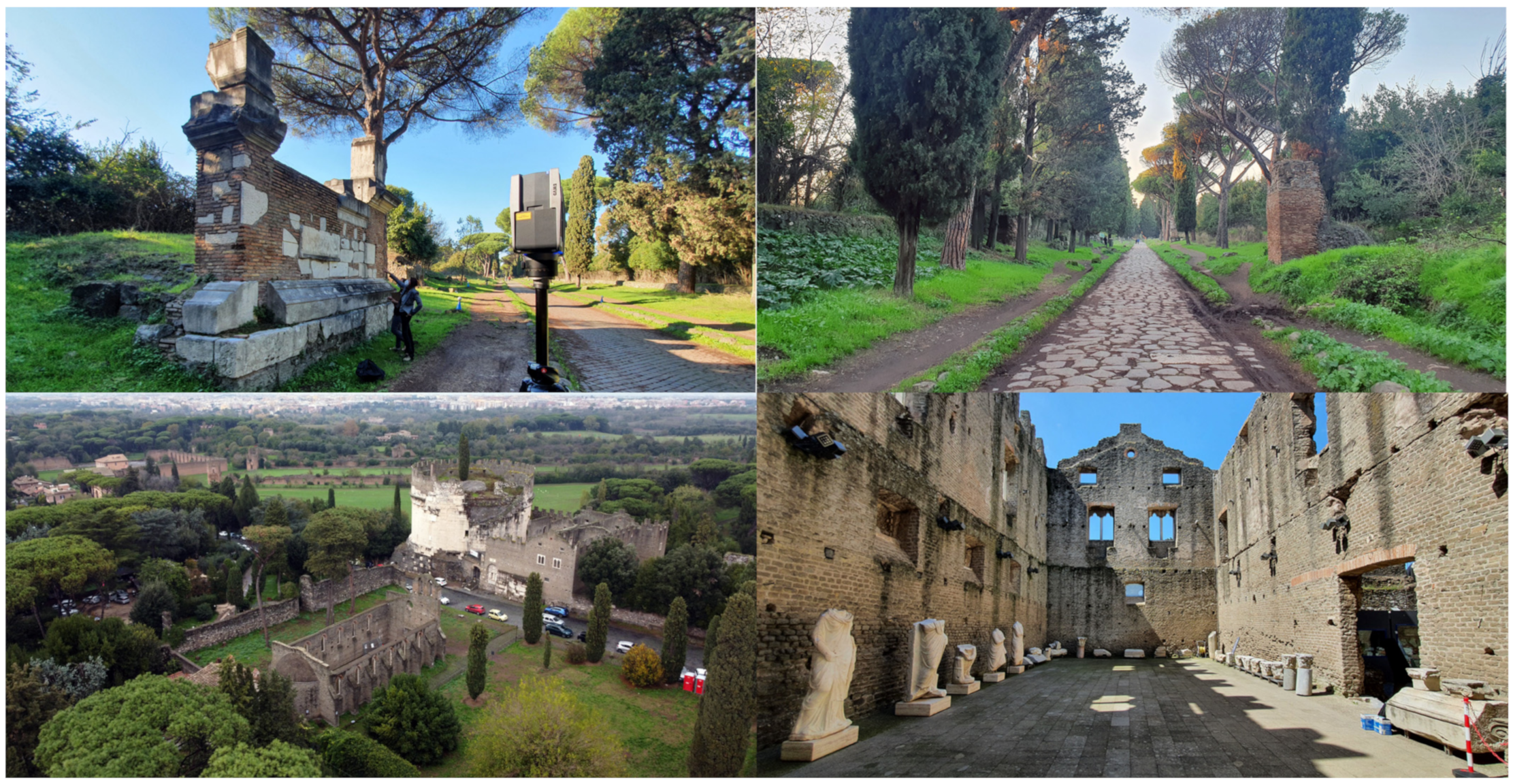
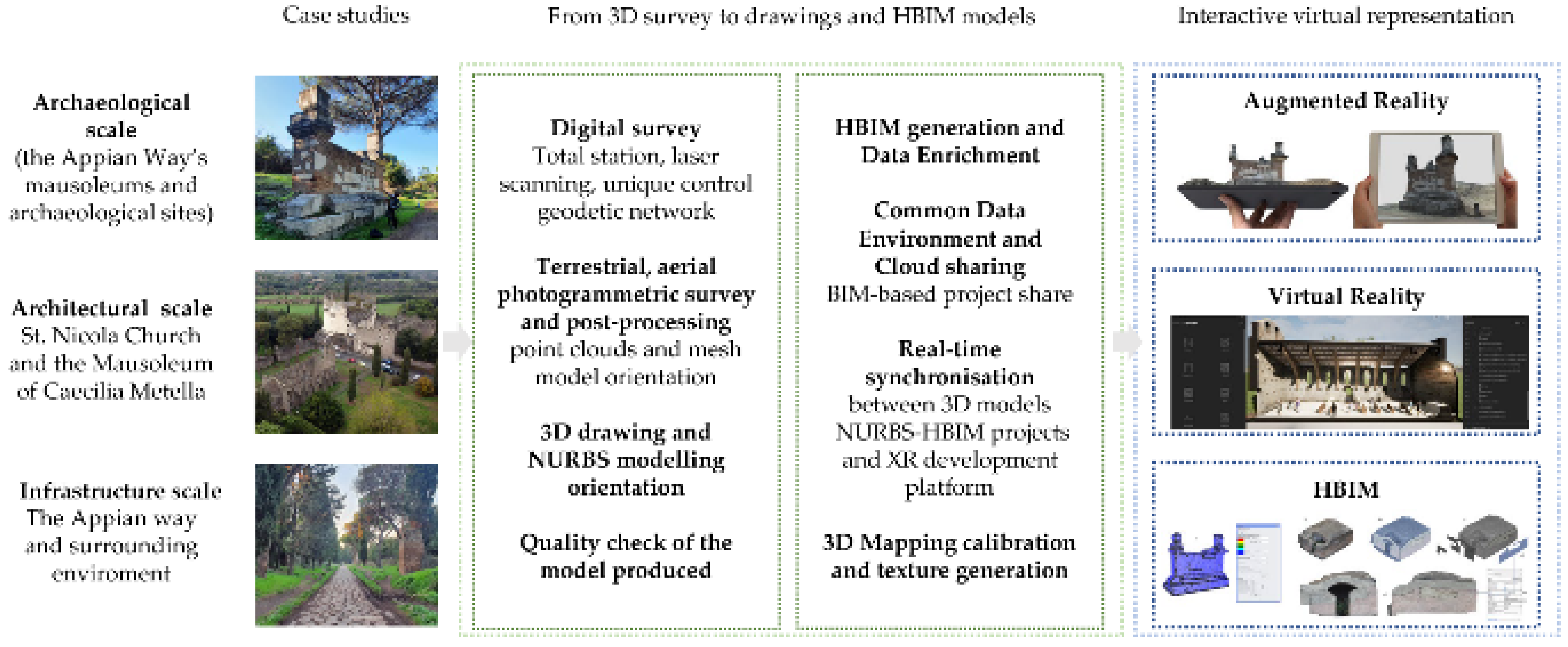
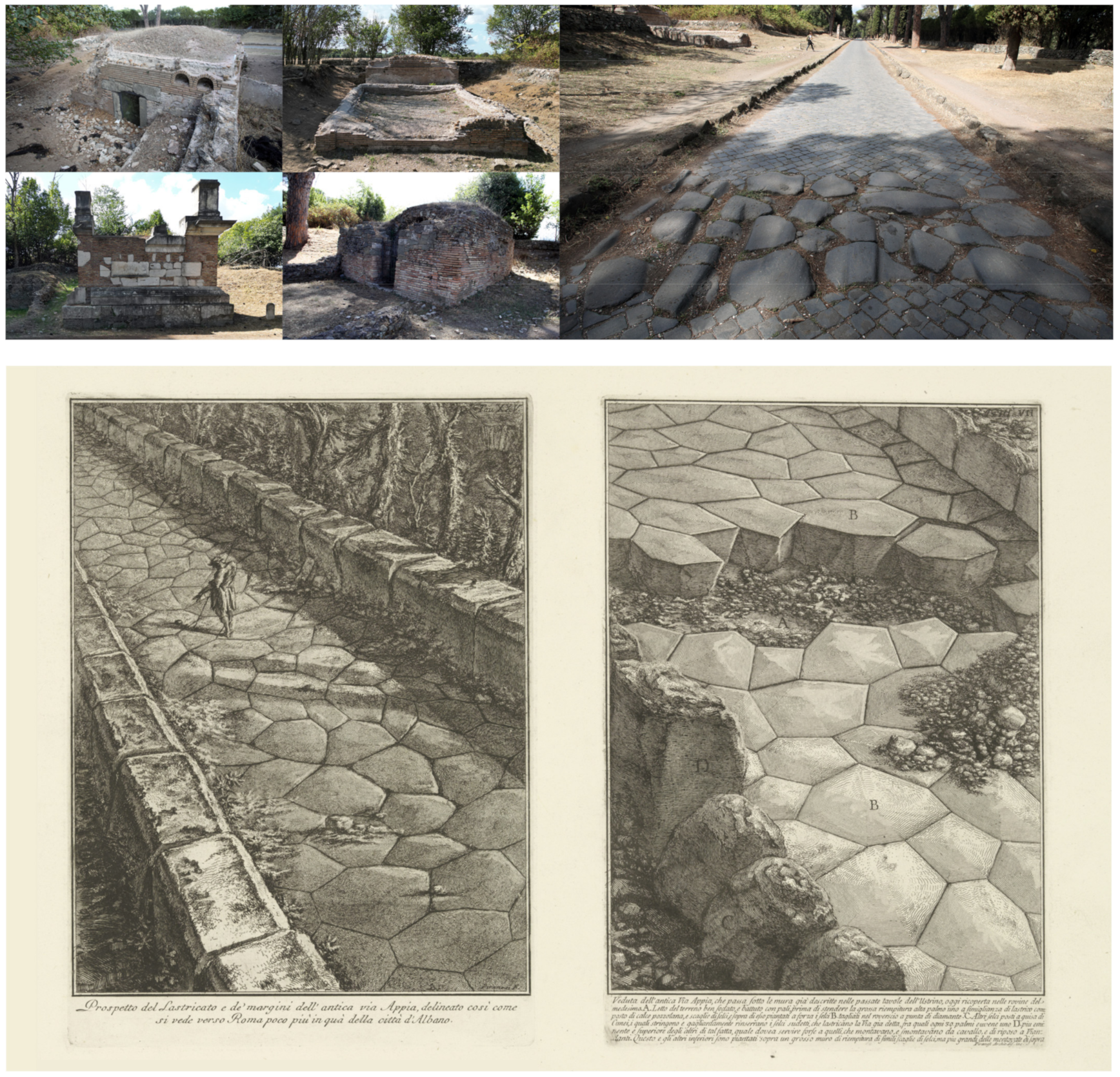
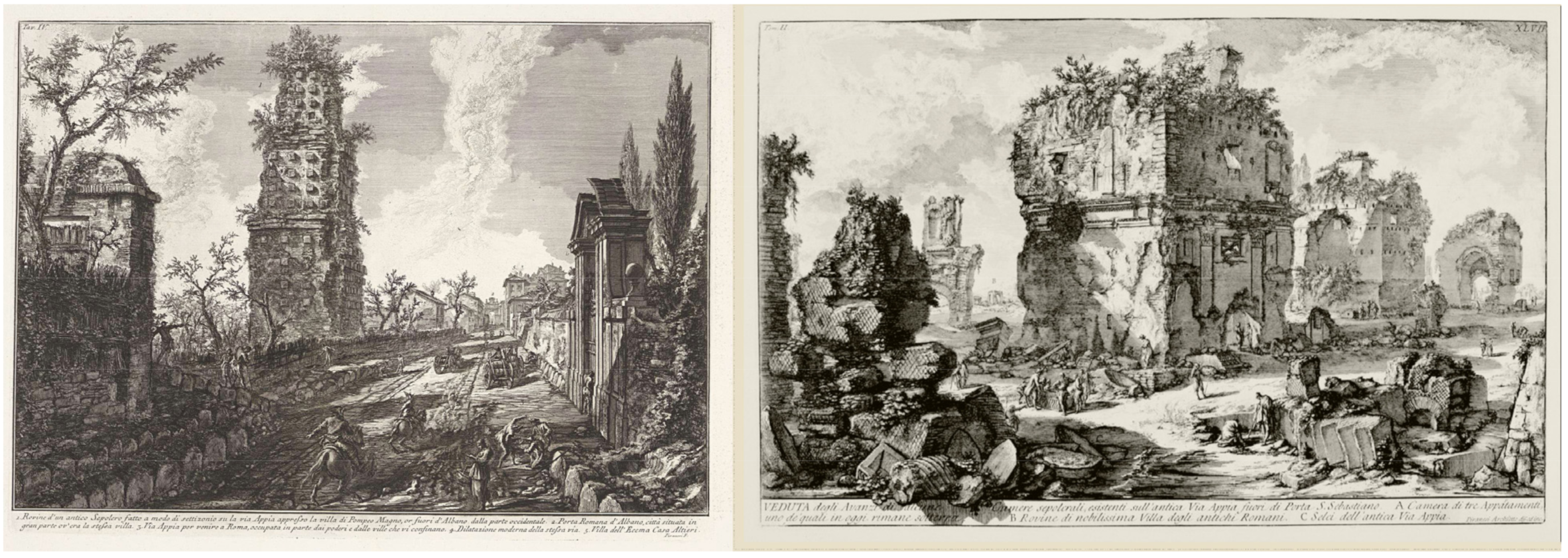
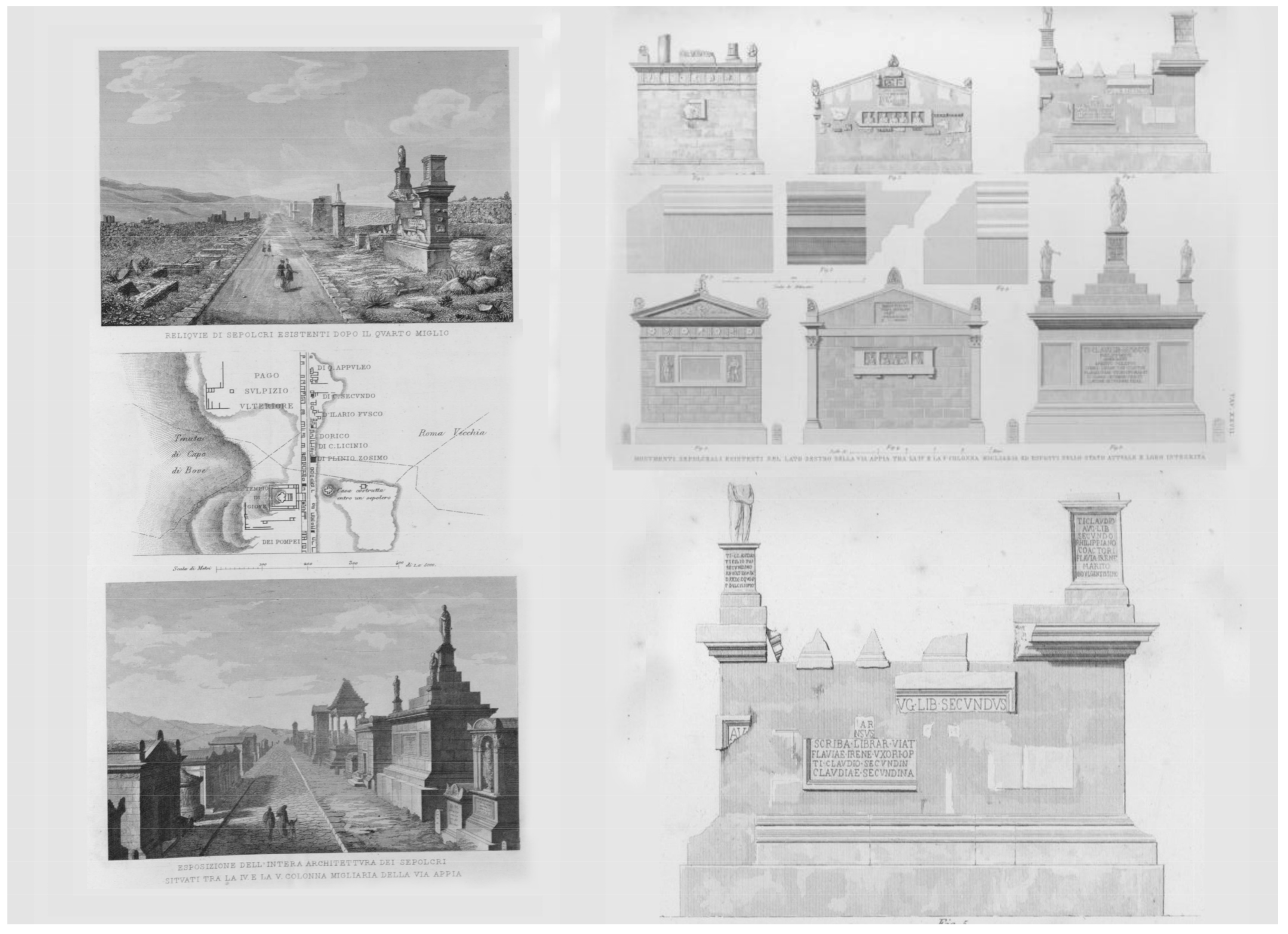

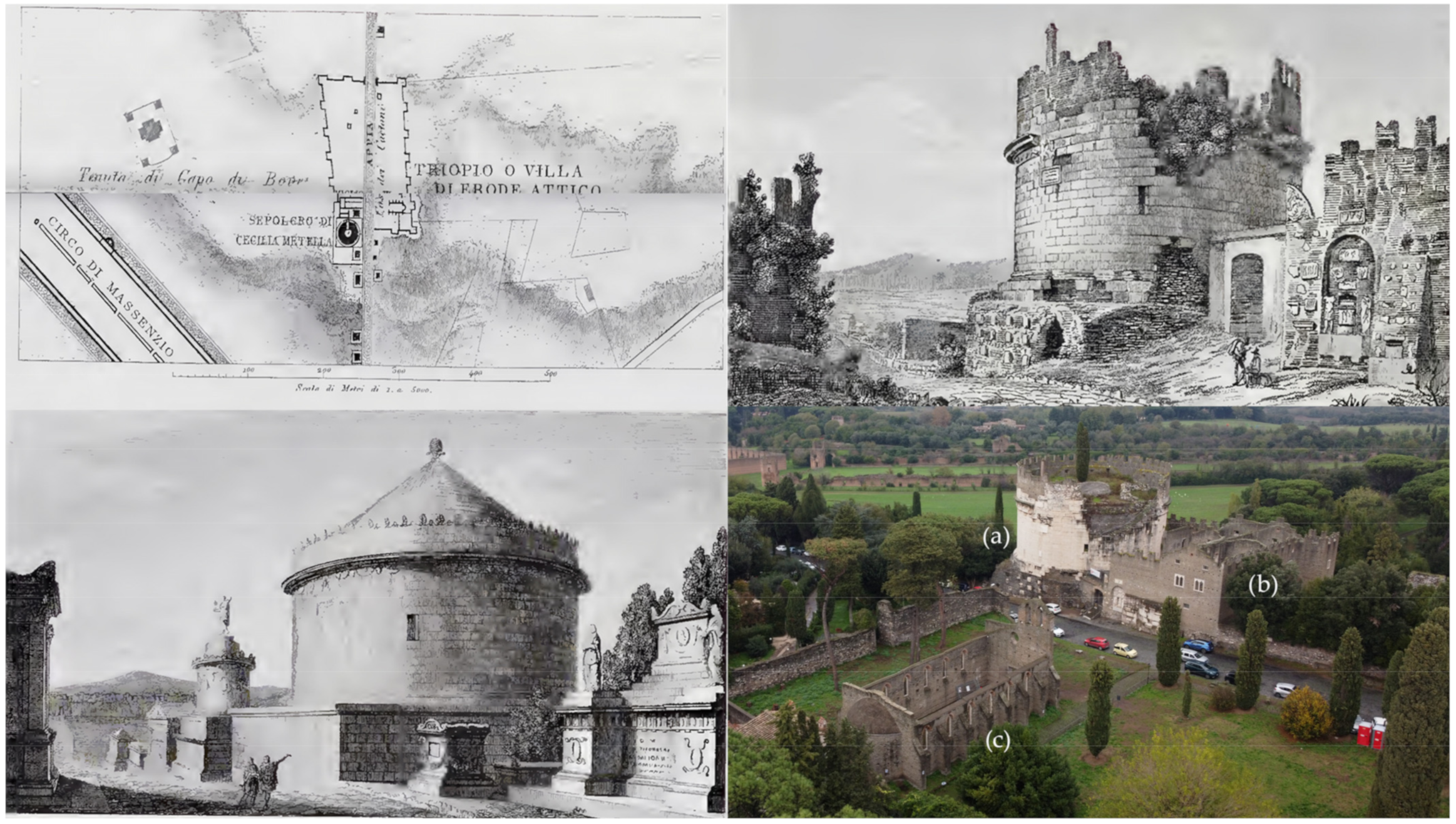
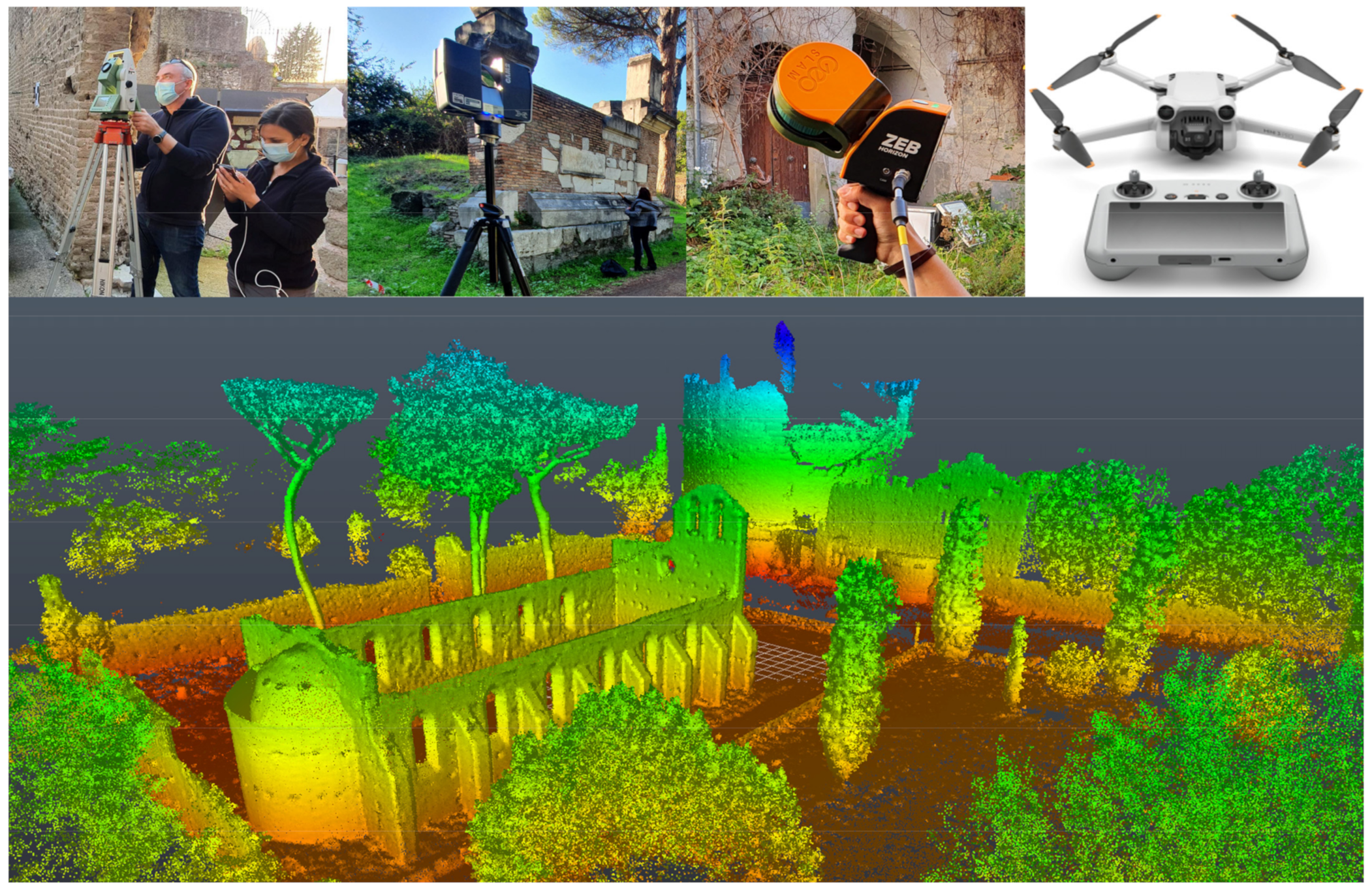
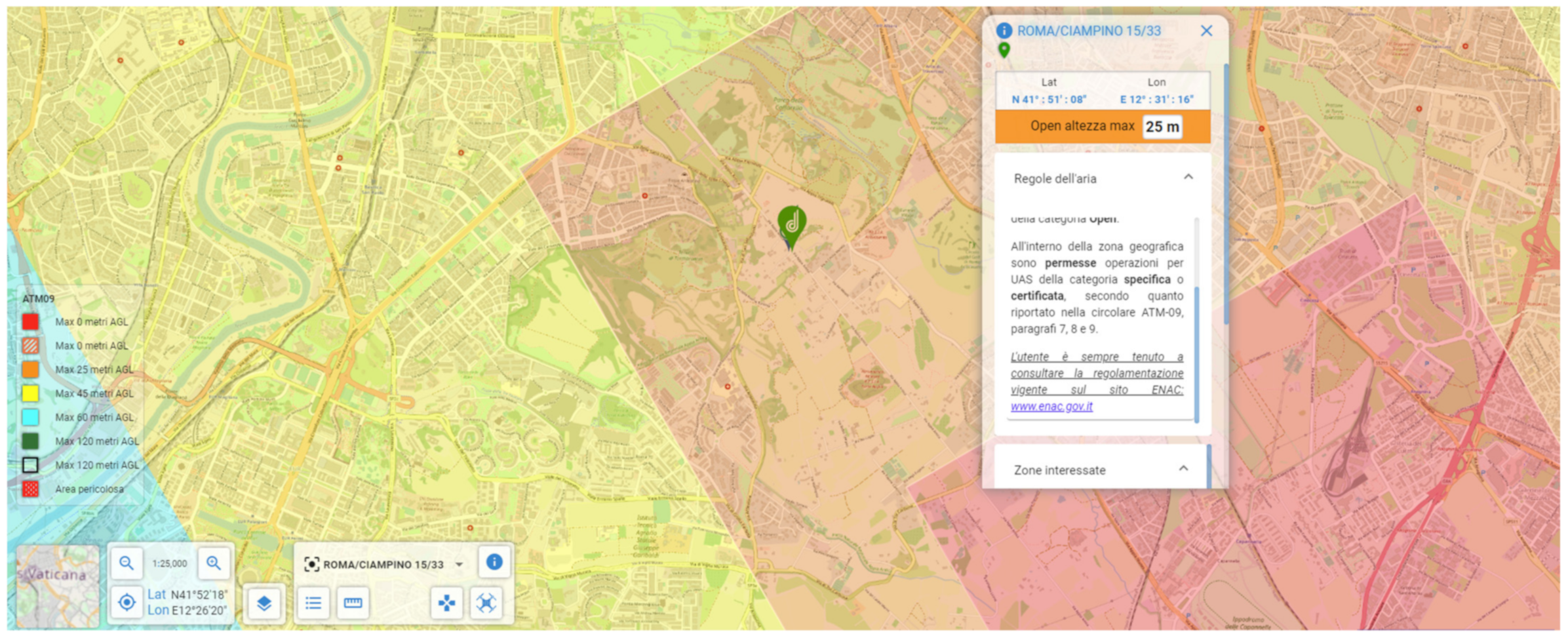

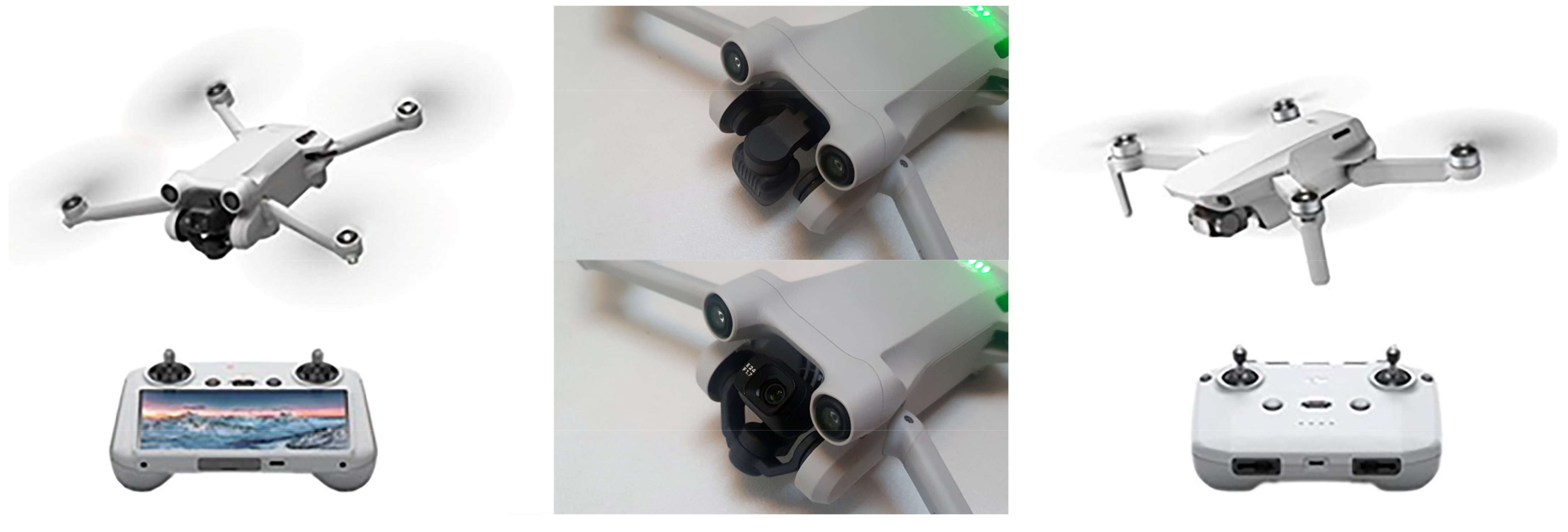
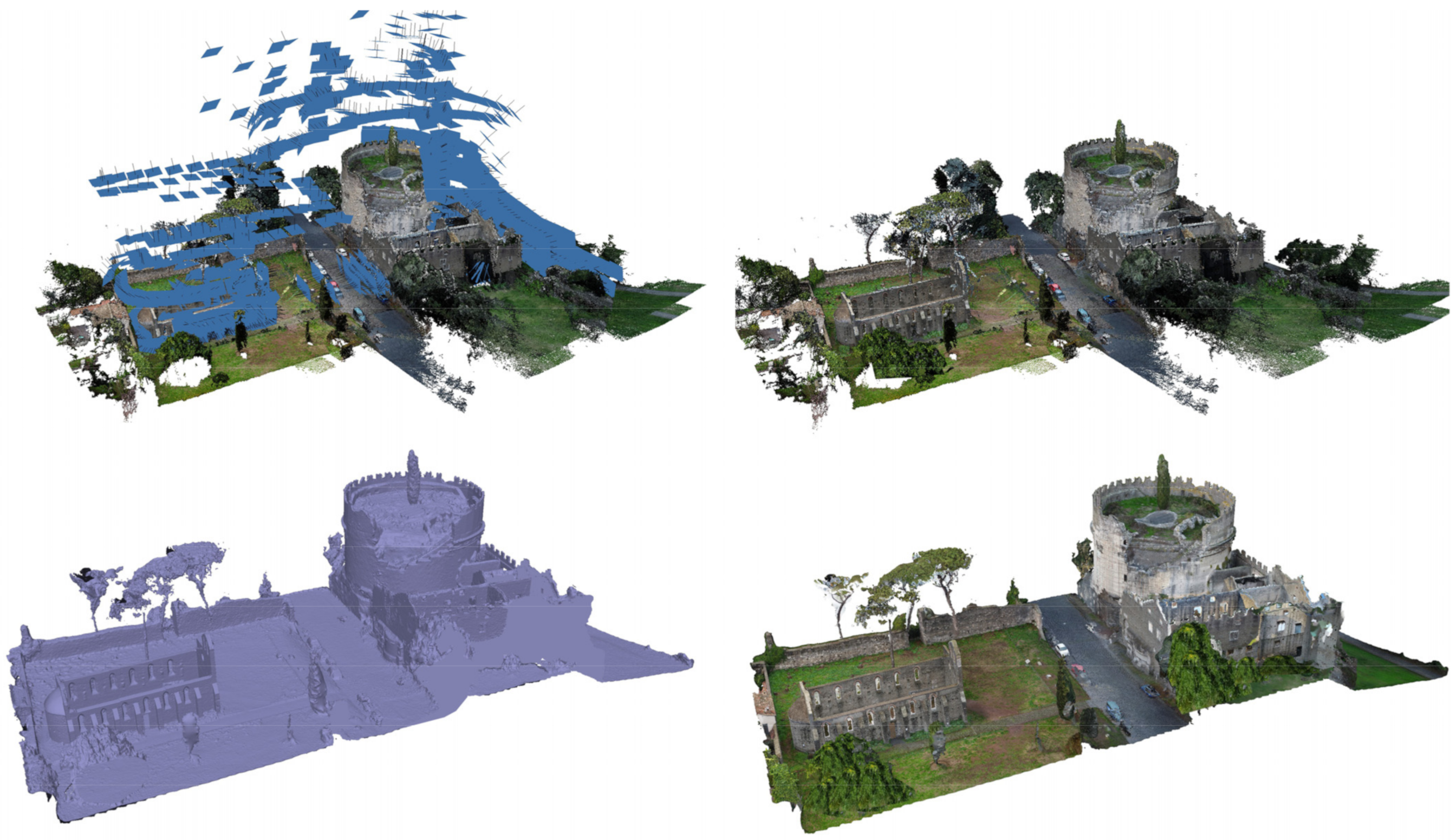

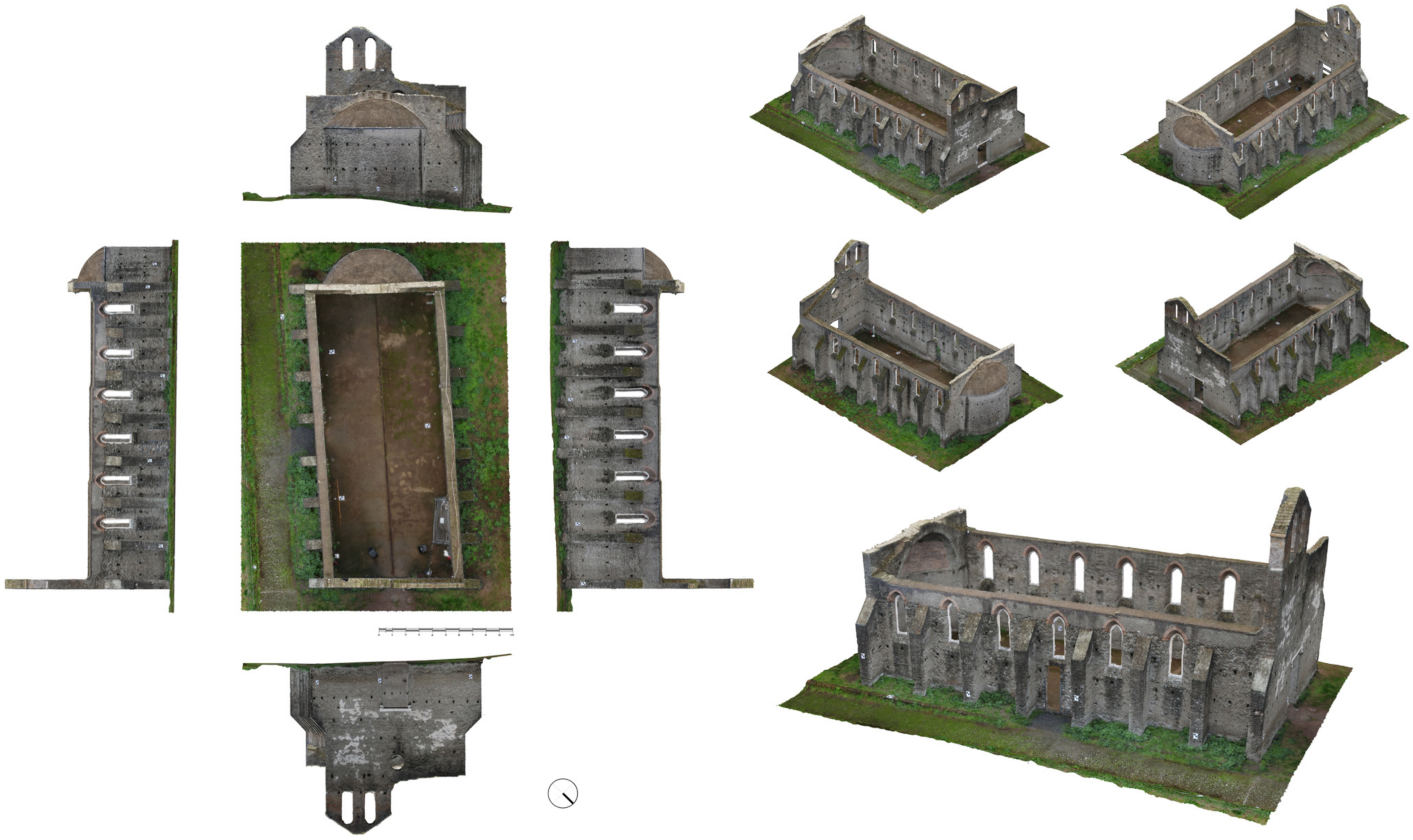
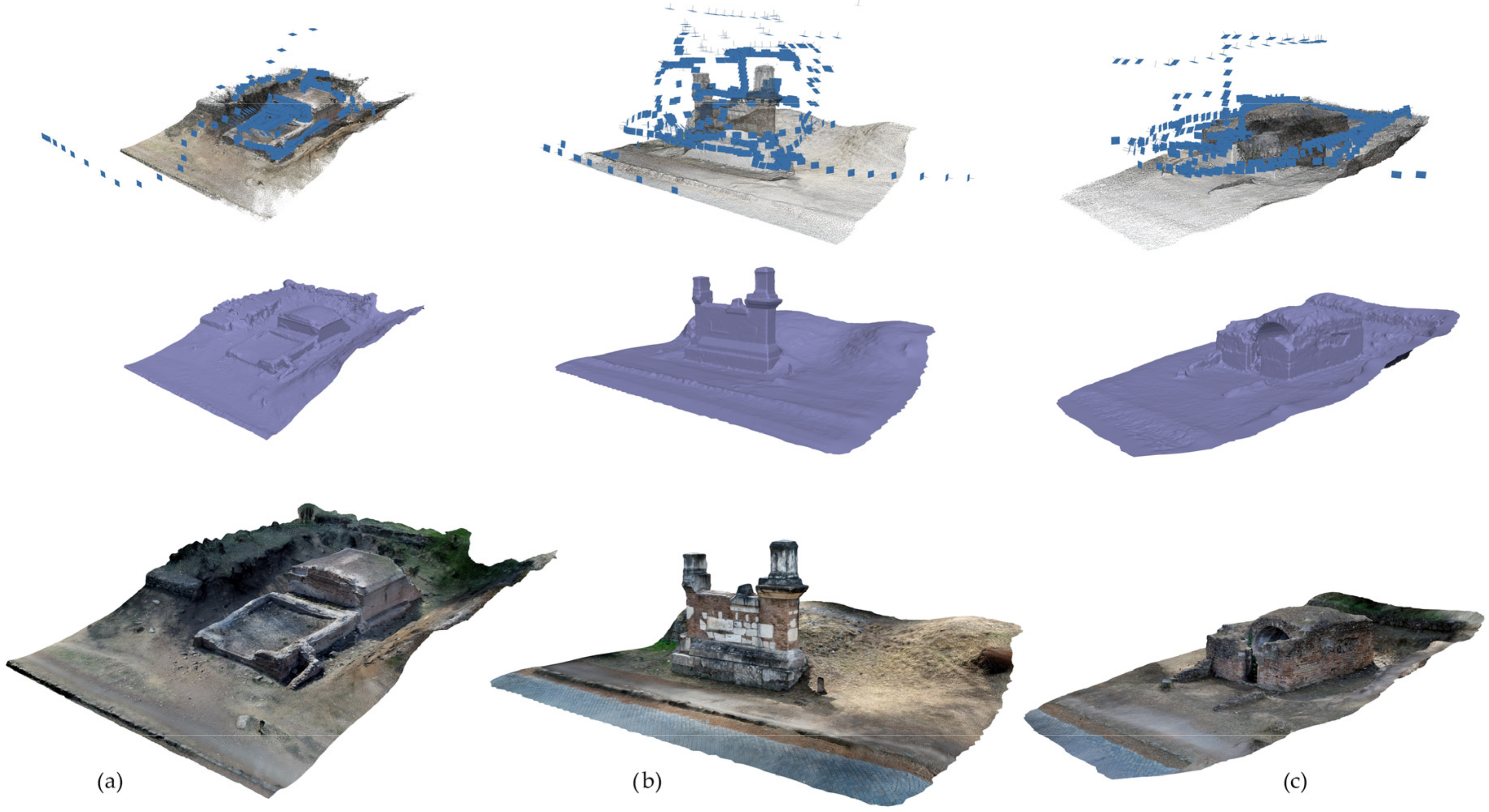

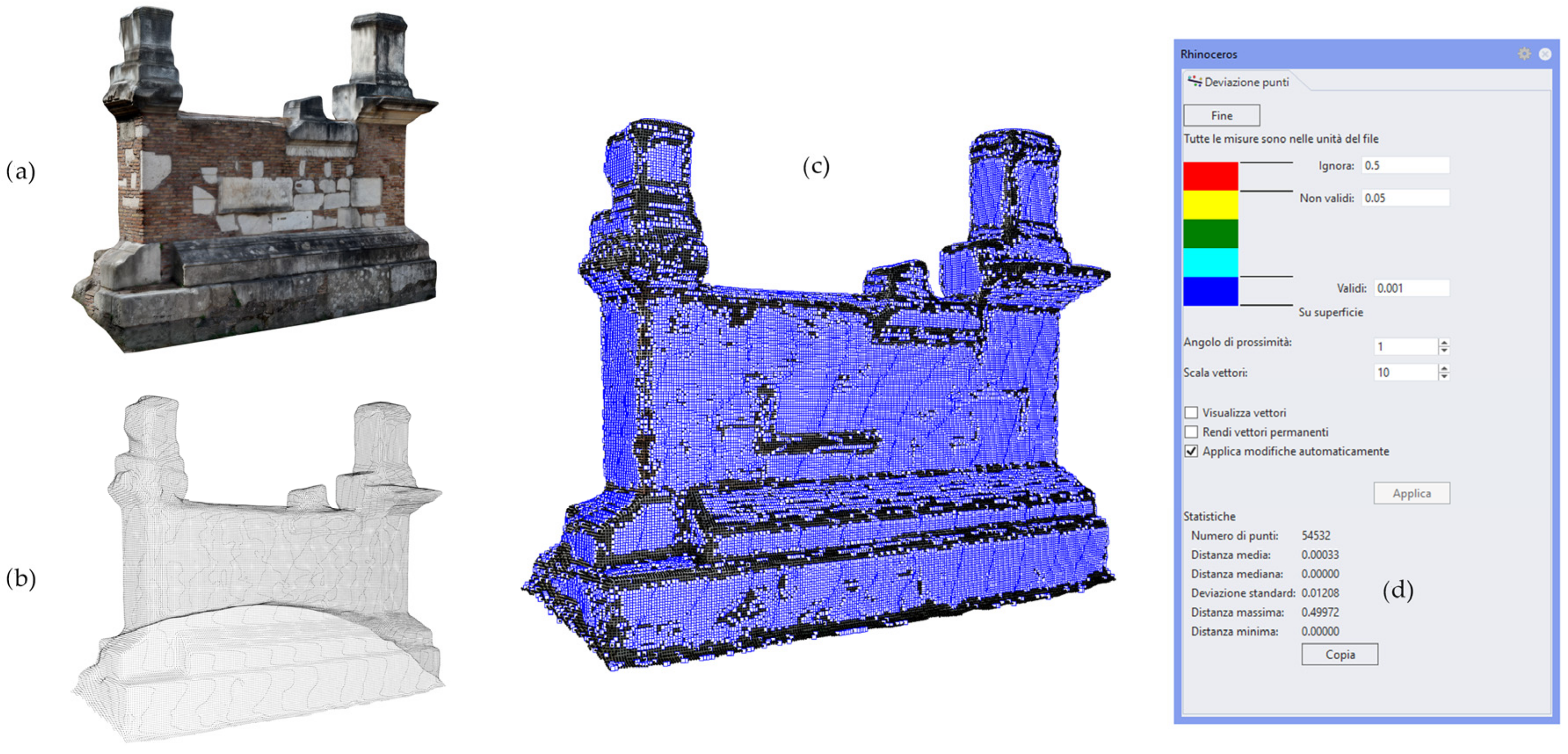
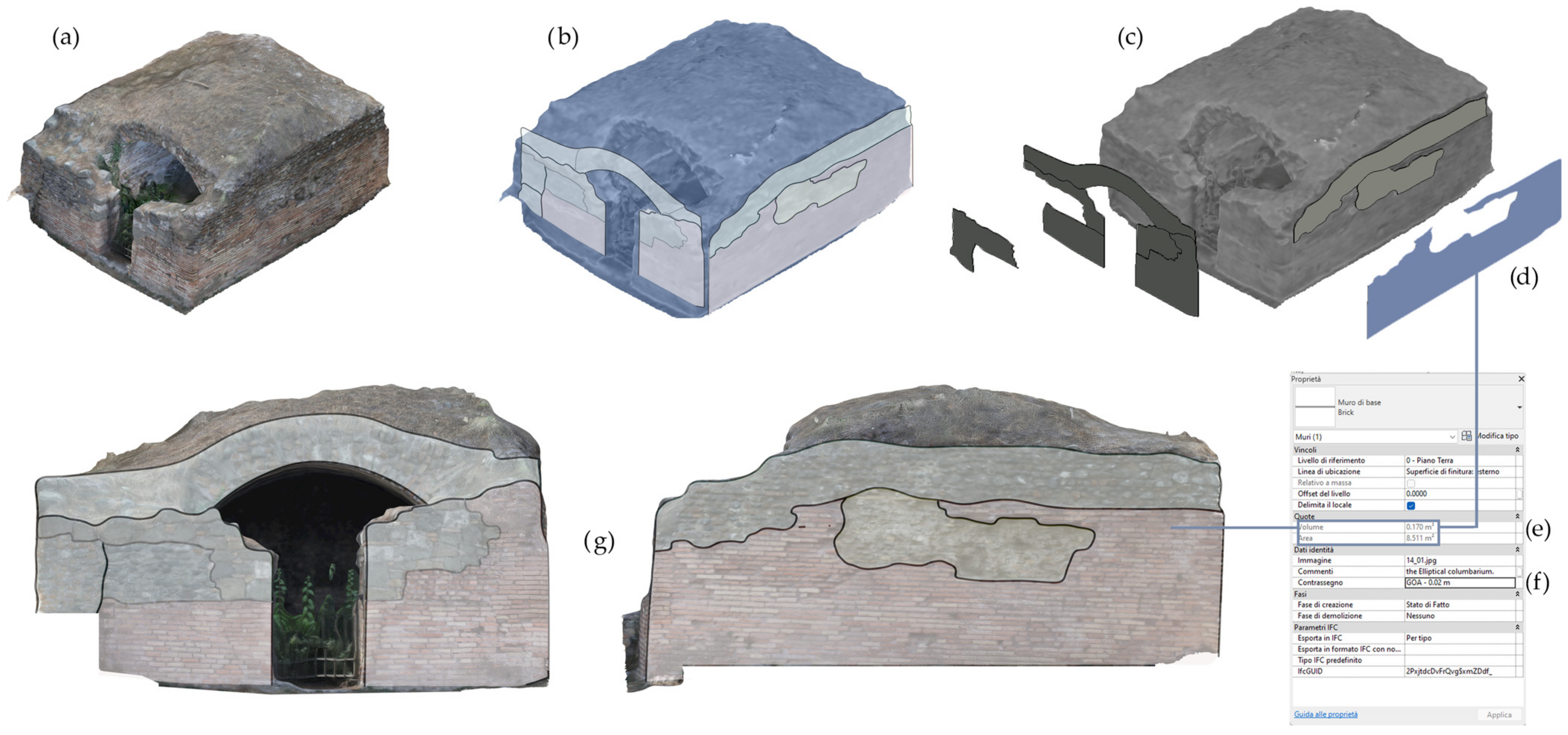
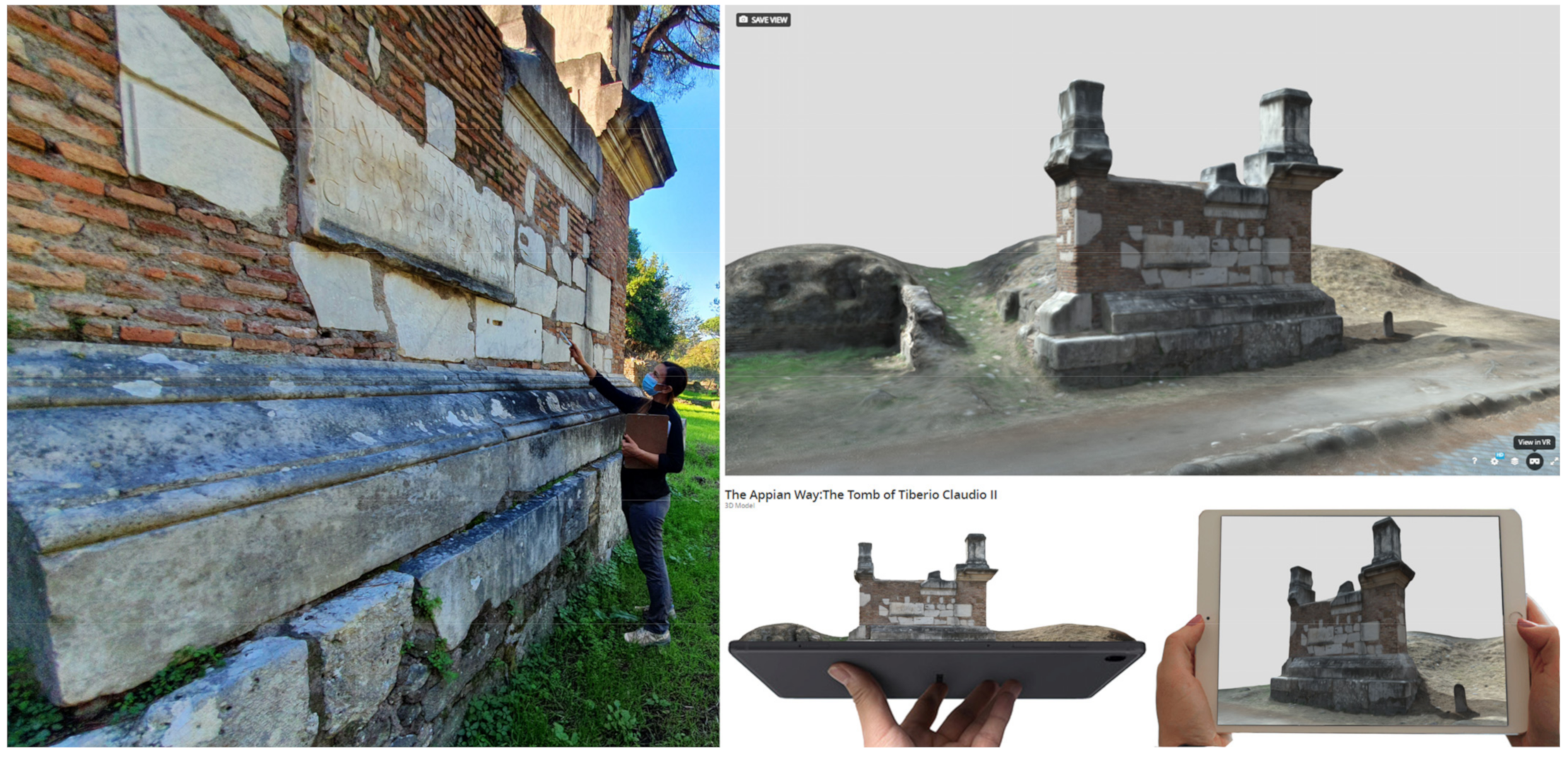
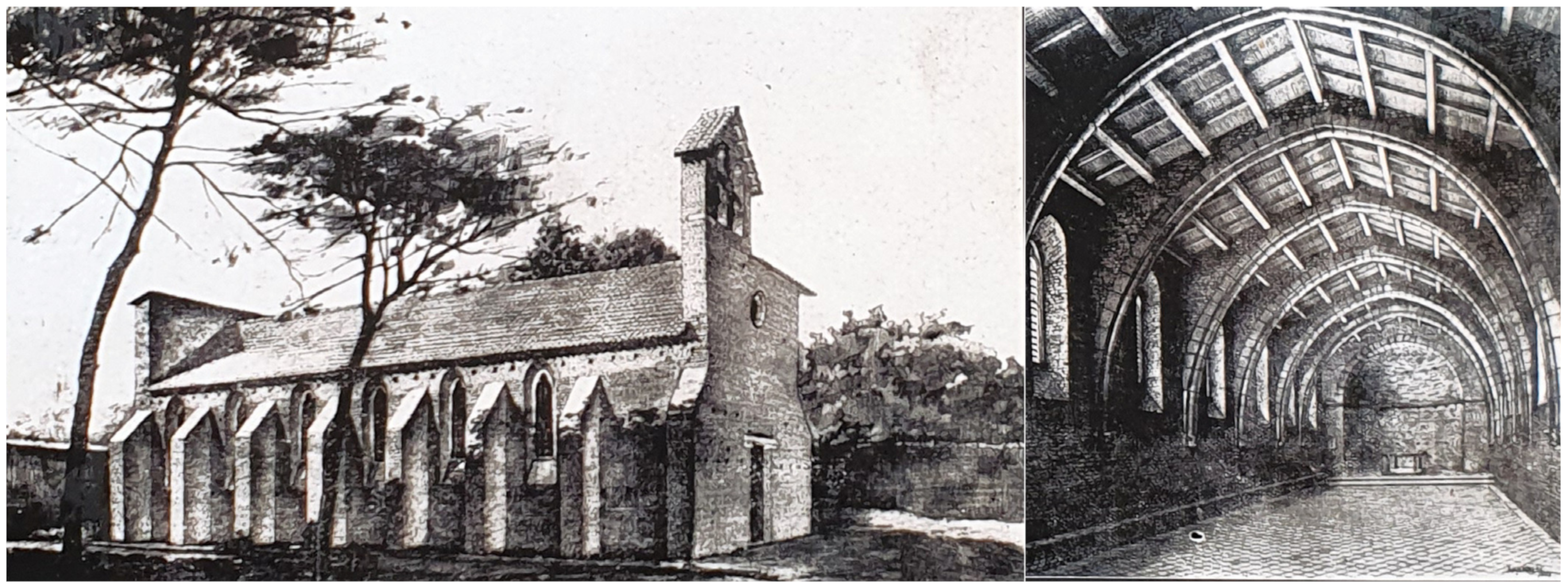
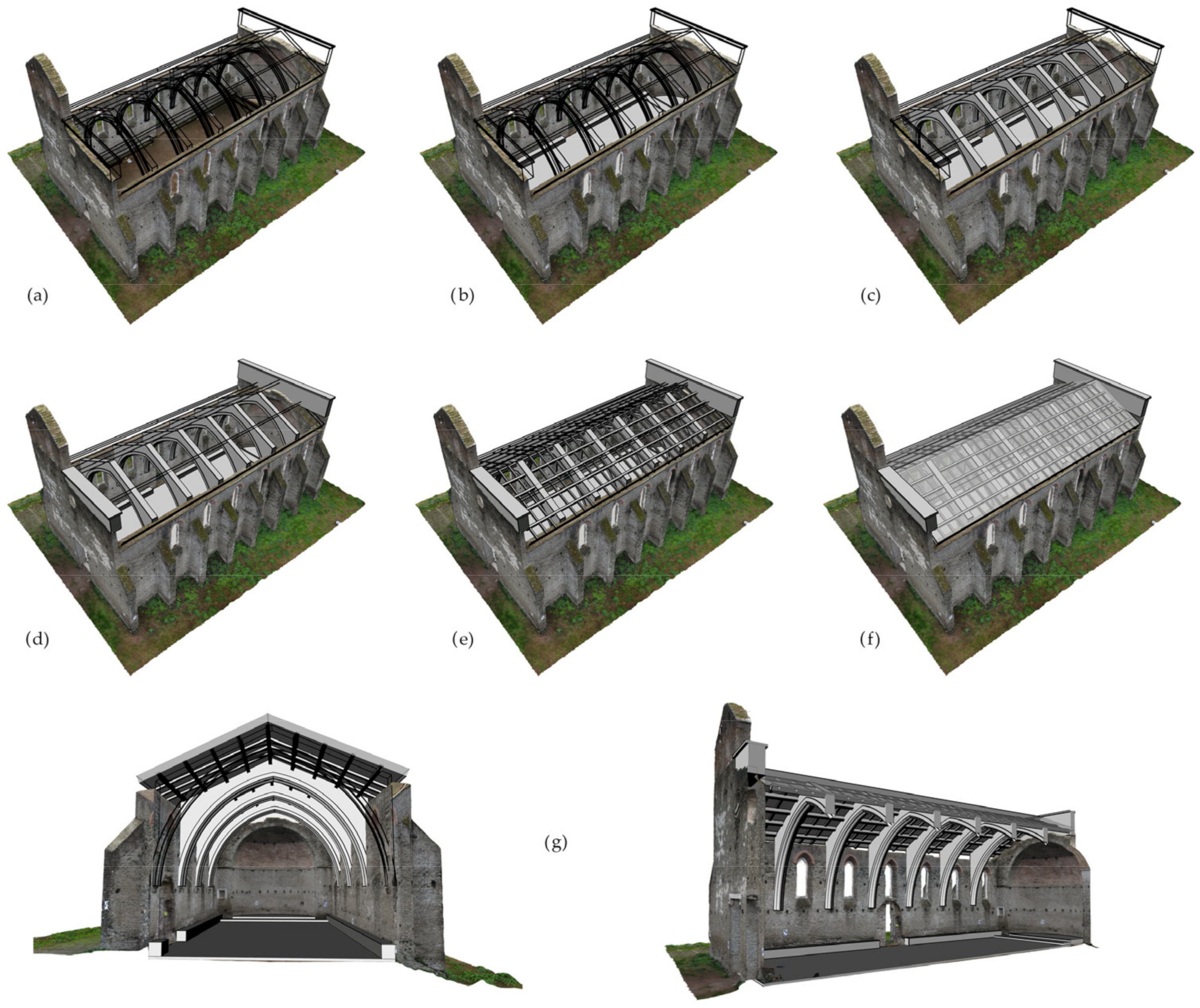
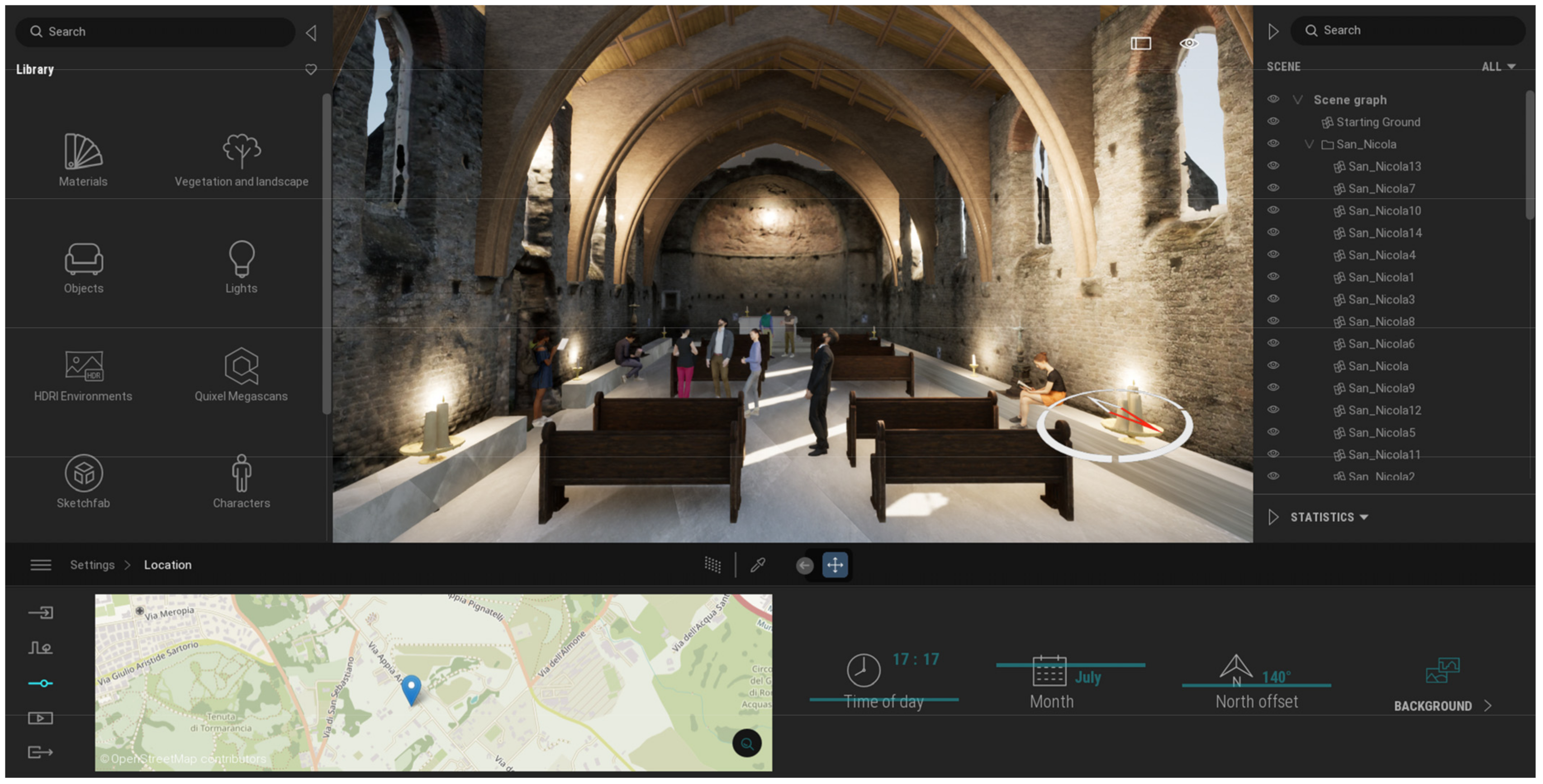
| DJI MINI 3 PRO | DJI MINI 2 | ||
|---|---|---|---|
| Sensor | Type | CMOS | CMOS |
| Dimension | 1/1.3″ | 1/2.3″ | |
| Lens | FOV | 82.1° | 83° |
| Aperture | f/1.7 | f/2.8 | |
| ISO | Min-Max | 100–6400 | 100–3200 |
| Resolution | 4:3 | 8064 × 6048 | 4000 × 3000 |
| 16:9 | 4032 × 2268 | 4000 × 2250 | |
| Battery life | Minutes | 34 | 31 |
| Proximity sensors | Yes/No | Yes | No |
Disclaimer/Publisher’s Note: The statements, opinions and data contained in all publications are solely those of the individual author(s) and contributor(s) and not of MDPI and/or the editor(s). MDPI and/or the editor(s) disclaim responsibility for any injury to people or property resulting from any ideas, methods, instructions or products referred to in the content. |
© 2023 by the authors. Licensee MDPI, Basel, Switzerland. This article is an open access article distributed under the terms and conditions of the Creative Commons Attribution (CC BY) license (https://creativecommons.org/licenses/by/4.0/).
Share and Cite
Banfi, F.; Roascio, S.; Mandelli, A.; Stanga, C. Narrating Ancient Roman Heritage through Drawings and Digital Architectural Representation: From Historical Archives, UAV and LIDAR to Virtual-Visual Storytelling and HBIM Projects. Drones 2023, 7, 51. https://doi.org/10.3390/drones7010051
Banfi F, Roascio S, Mandelli A, Stanga C. Narrating Ancient Roman Heritage through Drawings and Digital Architectural Representation: From Historical Archives, UAV and LIDAR to Virtual-Visual Storytelling and HBIM Projects. Drones. 2023; 7(1):51. https://doi.org/10.3390/drones7010051
Chicago/Turabian StyleBanfi, Fabrizio, Stefano Roascio, Alessandro Mandelli, and Chiara Stanga. 2023. "Narrating Ancient Roman Heritage through Drawings and Digital Architectural Representation: From Historical Archives, UAV and LIDAR to Virtual-Visual Storytelling and HBIM Projects" Drones 7, no. 1: 51. https://doi.org/10.3390/drones7010051
APA StyleBanfi, F., Roascio, S., Mandelli, A., & Stanga, C. (2023). Narrating Ancient Roman Heritage through Drawings and Digital Architectural Representation: From Historical Archives, UAV and LIDAR to Virtual-Visual Storytelling and HBIM Projects. Drones, 7(1), 51. https://doi.org/10.3390/drones7010051







